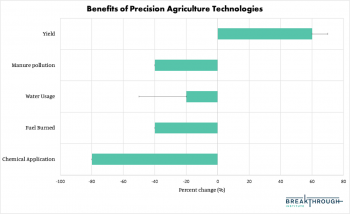Rural Broadband Funding in Bipartisan Infrastructure Bill Paves Way for Widespread Precision Agriculture, but Comes Up Short
COMMENTARY | The Ecomodernist

For weeks, I’ve been keeping my eye on one specific provision in the bipartisan infrastructure bill with enormous potential to lift communities out of poverty, address inequities, and, critically, transform our nation’s agricultural system: rural broadband. While much of the current discussion around rural broadband centers around conversations of equity and access, the funding still comes up short.
Specifically, the bipartisan bill sets aside $65 billion for broadband, attempting to finally close the digital gap. While $65 billion to expand service is laudable, the funding is insufficient. The Federal Communications Commission estimated that a total of at least $80 billion dollars is needed to get fiber-optic service to all unserved and underserved areas in the United States, including tribal lands and in communities of color where connectivity may be lower. Many last-mile communities would still be left out absent additional funding. Covering the last 2% of Americans in unserved areas costs $40 billion dollars alone. This is due to a combination of factors including low population density and rough terrain.
Broadband, like electrification, will be transformative for rural communities — and the federal government should look to the past to inspire action. In 1935, President Franklin D. Roosevelt created the Rural Electrification Administration, which provides loans to rural organizations to set up their own power systems. In two years, hundreds of municipal power utilities were set up with co-ops and large utilities. While Biden’s original plan provided support for networks owned or affiliated with local governments, non-profits, and cooperatives, the new bipartisan bill does not include such language. Expanding funding for the Rural Utilities Service, which absorbed the REA, is critical to closing the broadband gap. Unlike the FCC’s Universal Service Fund, which is focused on keeping broadband networks economically viable for providers and maintaining the affordability of services for users, the RUS provides grants and loans to build out new networks.
Federal funding for rural broadband infrastructure would provide much-needed economic opportunities. Rural communities with high levels of broadband access and adoption have higher household incomes and lower unemployment rates on average than communities with low levels. Expanding broadband can also lower poverty. In 2015, the rural broadband industry supported nearly 70,000 jobs and added $24.1 billion to the U.S. economy.
Last June, in the midst of the pandemic, I published a new report on rural broadband being a critical component of agricultural sustainability. I acknowledged and emphasized the other myriad improvements to the day-to-day lives expanded rural broadband would have on the lives of some of our most disadvantaged communities. The pandemic has exposed the shortcomings of this “digital divide” more than ever as online learning is impossible without access to high speed internet, inadequate telemedicine access makes it harder for people to see their doctors, and remote work is not an option.
These benefits are fundamentally good and necessary, but we should not overlook the potential for broadband to transform agriculture by increasing its efficiency and minimizing its impacts. A growing number of technologies, under the umbrella of “precision agriculture” require reliable and fast speeds, meanwhile, 29% of farms do not have access to the internet. The lack of sufficient broadband connectivity is the primary obstacle preventing more U.S. farms from adopting such technologies including sensors, variable-rate fertilizer and pesticide applicators, yield-mapping, and other GPS or GIS enabled technologies.
With PA technologies, farmers can more closely monitor their fields, animals, and weather conditions to more efficiently and effectively apply their inputs, while maximizing crop yields, cutting costs, and increasing revenues, thereby improving the profitability and sustainability of agriculture. About half of soy and corn farms use yield monitoring technologies, and nearly a third or less use other mapping, GPS-enabled tractor auto-steering, or variable-rate application technologies.
Currently, PA has improved fertilizer placement by 7%, but if widely adopted it would improve placement by 14% and cut emissions from fertilizer application and manufacturing by up to 32 million metric tons CO2e/year. PA has already decreased water usage by 4% and if widely adopted, it would reduce water usage by 20-50%. As described in the figure below, these farming techniques can reduce pesticide application by up to 80% and the amount of fuel burned by 40%. In my report, I found that full adoption of PA “could dramatically increase yields by 60-70% for corn, and generate $47-65 billion annually for the U.S. economy if broadband access and adoption matched producer demand.”

For livestock and dairy producers, widespread broadband and PA adoption would allow them to track disease and hunger with advanced cattle monitoring and to optimize feed formulation which would improve nutrition and reduce emissions and pollution. Precision livestock farming boosts worker safety too. Farmers could use facial recognition, microphones, and air sensors to monitor animal health while limiting contact with livestock. These technologies would amount to about $20 billion in gross economic benefits annually for the sector.
While PA adoption is highest on large farms, small producers, who currently have the least internet access and are more vulnerable to economic downturns, would benefit from lower labor and machinery costs associated with PA adoption on farms of their size. For example, adopting GPS-enabled auto steering tractors would improve efficiency by 20% on small farms and allow small farmers that depend on off-farm income to regain time and avoid fatigue associated with operating machinery.
Farmers — large and small — not only need increased broadband access to adopt PA, but also higher internet speeds. The bipartisan infrastructure bill reclassifies minimum speeds for downloads to 100 megabits per second (mbps) and 20 mbps for uploads from 25 and 3 mbps, respectively. New and existing networks will need to meet these new speeds. This is good news: fast speeds are needed for real-time data sharing between a farmer’s field and the digital cloud. As speeds increase, more devices can also be connected, allowing for more PA technologies to be deployed.
The bipartisan effort towards increasing broadband access and availability is a welcome effort that is still insufficient for the needs of America’s rural and agricultural communities. To rapidly improve connectivity, especially in rural areas that have been unserved, the federal government must consider ramping up funding in future spending bills and target new infrastructure projects that deliver fiber optic, high-speed service, especially as the pandemic has made video calls essential for work, school, and health. Broadband, like electrification, when universally delivered will be transformative and realize equally large environmental, agricultural, and economic benefits.
Saloni Shah is a food and agriculture analyst at The Breakthrough Institute. You can follow her on Twitter @SaloniShah101.























